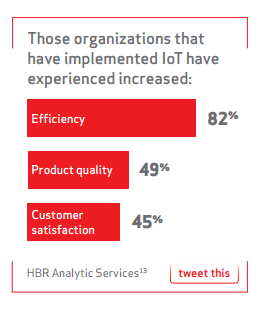Internet of things (IoT) for manufacturing
The internet of things has witnessed 204% growth YOY over 2014 in the manufacturing sector. Companies that have implemented the solution have reported an improvement in key metrics.
This means that it has grown faster in manufacturing than any other industry. The IoT for manufacturing solution is a bundle of technologies that consists of the most frequent applications in manufacturing.
- RFID Sensors: Inventory can be tracked in warehouses, shop floors and production lines. The tracking can go back to manufacturers, to-instransit goods, and downstream to retailers. This can help improve planing, improve pick-pack efficiency and can help reduce theft. Tracking can also be used to ensure perishable goods are kept in appropriate storage areas and in appropriate conditions throughout their journey.
- IoT-connected alarms, door locks, cameras, and tracking devices installed on plant, equipment, and stock
- Health and safety of workers. Sensors can monitors hazardous gases and explosive equipment.
- Improve worker performance. Sensors like the Microsoft Kinect can be used to monitor user behavior, tangibly measure their performance and efficiency throughout. Especially useful in night shifts.
- Production lines can be monitored to increase the resource utilization and to increase plant up-time by predicting failures.
- By adopting asset tracking throughout the supply chain — from inbound raw materials and parts to outbound shipments of finished products — manufacturers can
- Servitization: The process of charging customers for services rather than for the assets. e.g. Boeing charges for pounds of thrust, not the engine. IoT has enabled manufacturers to fundamentally change the pricing models because they can now keep a closer eye on their assets than ever before.
- Energy Management: IoT enabling devices can help plant managers optimize how much energy is being used when and by what machine enabling efficient planing and usage of energy – one of the biggest heads of expenditure in most plants.
Technologies
Tags
KEY BENEFITS

- Reduce shrinkage and damage
- Forecast material needs accurately
- Lower stock
- Fewer outages
- Predictive maintenance
- Increased up-time
- Theft prevention
- Increased Plant and Resource utilization
Explore how IT can help your business by
- Energy
- Border and Identity management
- Mining and Oil & Gas Extraction
- Telecommunications
- Pharmaceuticals and Healthcare
- Media and Publishing
- Chemicals
- Agriculture and Forestry
- Textile
- Electronics and High Tech
- Wholesale and Distribution
- FMCG
- Banking and Finance
- Automotive
- Insurance
- Retail
- Government and Public service
- Real Estate & Construction
- Non-Profit
- Freight, Logistics, Transportation & Warehousing
- Healthcare
- Accomodation and Food
- Construction & Engineering
- Education and Research
- Entertainment, Recreation and Arts
- Manufacturing
- Miscellaneous
- Professional and Technical Services
- Law services
- Utilities
- Travel and Tourism
- Finance and Accounting
- Human Resources
- Procurement, Supplier and Outsourcing
- Property and Facility
- Quality Improvement and Innovation
- Supply Chain, Inventory and Logistics
- Support
- Project Management and governance
- Operations
- Information Technology
- Manufacturing
- Sales and Marketing
- Improving Asset Efficiency
- Inventory
- PP&E
- Receivables & Payyables
- Increase Operating Margin
- COGS
- Income Taxes
- SG&A
- Managing Market Expectations
- Revenue Growth
- Price Realization
- Revenue Volume
- Business Intelligence
- BigData
- Enterprise Application Integration
- Internet Of Things (IoT)
- Mobile
- SharePoint
- Virtual Reality
- Web
- Collaboration
Explore how IT can help your business by
- Government and Public service
- Real Estate & Construction
- Non-Profit
- Freight, Logistics, Transportation & Warehousing
- Healthcare
- Accomodation and Food
- Construction & Engineering
- Education and Research
- Entertainment, Recreation and Arts
- Manufacturing
- Miscellaneous
- Professional and Technical Services
- Law services
- Utilities
- Travel and Tourism
Recent Blogs
Straddling these two worlds makes for a hell of a person. It’s a fire sign and ruled by the headstrong Ram, making them stand their ground and refuse to be pushed around. Conventional family values are something they strictly follow, for example https://astrozella.com/may-taurus-vs-april-taurus/. So, she will do anything within her means to ensure it clings to every chance that pops up in her career.
If that’s not enough, you can share photos on social media and do more, thanks to IFTTT. There were a ton of backpackers there on longer term trips also interested in hanging out, tons of cheap activities and cheap steak so people can do stuff together easily, and even stayed at a hostel with free wine! Because they are an active dog breed, the Vizsla needs something to keep them busy if they are left alone – like a puzzle treat box or a proper dog toy more info. It’s no surprise, but summer is peak tourism season for Kennebunk, Kennebunkport, and the surrounding area, and like most of Maine’s coastal towns, the Kennebunks turn into sleepy towns in the winter.
The cup should encompass your breast and provide a smooth transition from bra to breast, with no skin squeezing out of the top. The wings stimulate your lateral clitor. The shape of the toy and the weight of the steel do a lot of the work for you https://kinkazoid.com/male-masturbators/. A DIY pussy will help you reach the climax, but it can’t be compared to the one you can get with professional models from Spider, Meiki, Fleshlight or Rends.
For women, this can be a great way to control the amount of stimulation they’re receiving. Odette Lace Eye Mask Black. Since we’re on the topic of long term wear I’ll address the second most asked question: How do you go to the bathroom https://911cashtilpayday.com/. In case you forgot that the internet is full of pretenders and people who say they’re something or someone they aren’t, we’ll remind you again.
Physical arousal involves direct and indirect stimulation of erogenous sensory nerves. Still, it’s fair to say that none of these choices are purely aesthetic, and the Tentacle’s form does provide some amazing texture and stimulation. Variations: Dildo choices are endless, and range in size, shape, and color dildo mouth gag. With sturdy nylon straps that can hold up to 250 pounds, you and your partner can take turns swinging and turning as you experiment with multiple sex positions.



